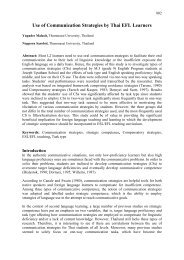The Effects of Semantic Mapping on Vocabulary Memorizing
The Effects of Semantic Mapping on Vocabulary Memorizing
The Effects of Semantic Mapping on Vocabulary Memorizing
You also want an ePaper? Increase the reach of your titles
YUMPU automatically turns print PDFs into web optimized ePapers that Google loves.
organize words in a systematical way and created a semantic link between the words by the<br />
topics or by the ideas in the c<strong>on</strong>text. This required the students a deeper mental processing to<br />
find out the relati<strong>on</strong>s between the words and to build up a net <str<strong>on</strong>g>of</str<strong>on</strong>g> words. As a result, the students<br />
could remember the words right after the less<strong>on</strong>s, most <str<strong>on</strong>g>of</str<strong>on</strong>g> them could transfer the words they<br />
learnt into l<strong>on</strong>g-term memory and revised the semantic map created for c<strong>on</strong>solidati<strong>on</strong>. <str<strong>on</strong>g>The</str<strong>on</strong>g><br />
improvement in memory, in turn, resulted in retrieval.<br />
1.2 <str<strong>on</strong>g>The</str<strong>on</strong>g> students’ attitudes towards using semantic mapping<br />
<str<strong>on</strong>g>The</str<strong>on</strong>g> results from the questi<strong>on</strong>naire indicated that the students had positive attitudes towards the<br />
use <str<strong>on</strong>g>of</str<strong>on</strong>g> semantic mapping (M = 3.69, t = -3.69, df = 29, p = .001). Noticeably, the results obtained<br />
from the fourth and fifth questi<strong>on</strong>s in the interview showed that all <str<strong>on</strong>g>of</str<strong>on</strong>g> the students expressed their<br />
positive attitudes towards the use <str<strong>on</strong>g>of</str<strong>on</strong>g> semantic mapping.<br />
Answering the fourth questi<strong>on</strong> about whether it is effective or ineffective to use the semantic<br />
mapping to memorize vocabulary, all <str<strong>on</strong>g>of</str<strong>on</strong>g> the students accepted that it is effective. However, <strong>on</strong>e<br />
said that it required an available amount <str<strong>on</strong>g>of</str<strong>on</strong>g> vocabulary when using the semantic mapping. One<br />
agreed that it was critical for students who were not good at English. Two students admitted that<br />
it took them a l<strong>on</strong>g time to be acquainted with its usage.<br />
With regard to questi<strong>on</strong> five: “Why do you think it is effective or ineffective to use the semantic<br />
mapping to memorize vocabulary?” the students had different ideas. Four <str<strong>on</strong>g>of</str<strong>on</strong>g> the students<br />
reported that the semantic mapping helped them summarize the related words to each other. Two<br />
said that thanks to the semantic mapping, they could review the known words when learning a<br />
new word while the other two could recall other words with the related meanings. Five <str<strong>on</strong>g>of</str<strong>on</strong>g> the<br />
students reported that the semantic mapping helped retain the meanings <str<strong>on</strong>g>of</str<strong>on</strong>g> the words for a l<strong>on</strong>g<br />
time. One said he could apply the semantic mapping into other subjects because he thought using<br />
the semantic mapping was logical in the way <str<strong>on</strong>g>of</str<strong>on</strong>g> putting the related words into a map.<br />
One explanati<strong>on</strong> for the students’ attitudes towards using semantic mapping might be that the<br />
semantic mapping brought the students a new trial in their learning vocabulary. Teaching and<br />
learning vocabulary by using word lists made them bored and tired. Moreover, memorizing<br />
vocabulary using word lists hardly made progress in the students’ vocabulary learning. In<br />
c<strong>on</strong>trast, the semantic mapping used in this study attracted the attenti<strong>on</strong> <str<strong>on</strong>g>of</str<strong>on</strong>g> both the teacher and<br />
her students. For the teacher, it was <strong>on</strong>e <str<strong>on</strong>g>of</str<strong>on</strong>g> the ways to present words logically. It was also a tool<br />
to check the students’ understanding as it assisted them in summarizing the less<strong>on</strong>s <strong>on</strong> maps. For<br />
the students, they were provided a new strategy to learn vocabulary, which made them feel<br />
interested and motivated when working with words.<br />
Besides, the semantic mapping created more interacti<strong>on</strong>s in the class. That might be another<br />
reas<strong>on</strong> to explain why the students had positive attitudes towards using semantic mapping. <str<strong>on</strong>g>The</str<strong>on</strong>g><br />
students themselves worked together to find out the relati<strong>on</strong>s between words, to create a nets <str<strong>on</strong>g>of</str<strong>on</strong>g><br />
words and to enlarge their vocabulary knowledge. <str<strong>on</strong>g>The</str<strong>on</strong>g>y also interacted with the teacher to get<br />
assistance for their learning. Interacti<strong>on</strong>s provided the students with opportunities to receive<br />
comprehensible input and feedback (Gass, 1997; L<strong>on</strong>g, 1996; Pica, 1994) as well as to make<br />
changes in their linguistic output (Swain, 1995). In additi<strong>on</strong>, the interacti<strong>on</strong>s in vocabulary<br />
654






